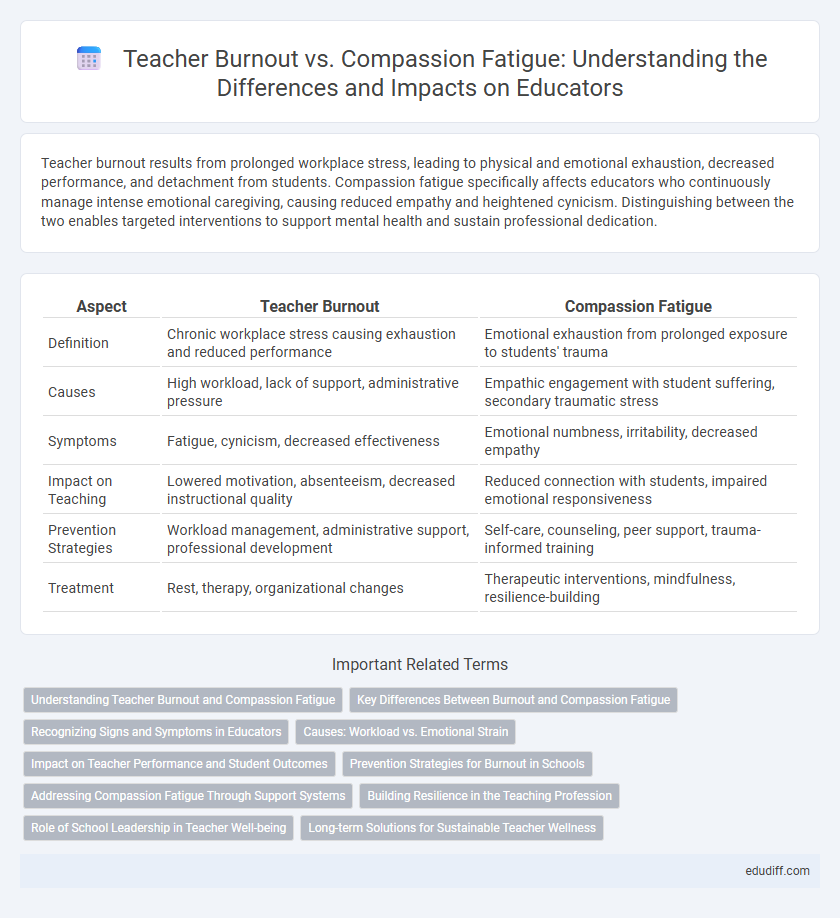Teacher burnout results from prolonged workplace stress, leading to physical and emotional exhaustion, decreased performance, and detachment from students. Compassion fatigue specifically affects educators who continuously manage intense emotional caregiving, causing reduced empathy and heightened cynicism. Distinguishing between the two enables targeted interventions to support mental health and sustain professional dedication.
Table of Comparison
| Aspect | Teacher Burnout | Compassion Fatigue |
|---|---|---|
| Definition | Chronic workplace stress causing exhaustion and reduced performance | Emotional exhaustion from prolonged exposure to students' trauma |
| Causes | High workload, lack of support, administrative pressure | Empathic engagement with student suffering, secondary traumatic stress |
| Symptoms | Fatigue, cynicism, decreased effectiveness | Emotional numbness, irritability, decreased empathy |
| Impact on Teaching | Lowered motivation, absenteeism, decreased instructional quality | Reduced connection with students, impaired emotional responsiveness |
| Prevention Strategies | Workload management, administrative support, professional development | Self-care, counseling, peer support, trauma-informed training |
| Treatment | Rest, therapy, organizational changes | Therapeutic interventions, mindfulness, resilience-building |
Understanding Teacher Burnout and Compassion Fatigue
Teacher burnout manifests through chronic physical and emotional exhaustion, diminished motivation, and feelings of ineffectiveness, often resulting from prolonged workplace stress and heavy demands. Compassion fatigue specifically arises from emotional strain linked to constant exposure to students' trauma and suffering, leading to reduced empathy and emotional numbness. Distinguishing these conditions enables targeted intervention strategies that enhance teacher well-being and sustain educational effectiveness.
Key Differences Between Burnout and Compassion Fatigue
Teacher burnout primarily arises from chronic workplace stress leading to emotional exhaustion, reduced efficacy, and depersonalization, while compassion fatigue stems from prolonged exposure to students' trauma, causing secondary traumatic stress and emotional depletion. Burnout often results in decreased motivation and productivity, whereas compassion fatigue manifests through feelings of helplessness and a diminished capacity for empathy. Understanding these key differences is crucial for implementing targeted interventions to support educators' mental health and sustain effective teaching practices.
Recognizing Signs and Symptoms in Educators
Teacher burnout manifests through chronic exhaustion, reduced efficacy, and frequent feelings of detachment from work, while compassion fatigue is characterized by emotional numbness and a decreased ability to empathize with students' struggles. Recognizing signs like persistent irritability, declining classroom performance, increased absenteeism, and emotional withdrawal is crucial for timely intervention. Early identification through self-assessment tools and peer feedback can prevent long-term psychological distress and improve educator well-being.
Causes: Workload vs. Emotional Strain
Teacher burnout primarily stems from excessive workload, including long hours, grading, and administrative tasks that lead to physical and mental exhaustion. Compassion fatigue results from continuous emotional strain caused by empathizing with students' trauma and behavioral challenges. Understanding these distinct causes is essential for implementing targeted interventions to support educators' well-being.
Impact on Teacher Performance and Student Outcomes
Teacher burnout, characterized by emotional exhaustion and reduced efficacy, significantly diminishes instructional quality and classroom management, leading to lower student engagement and academic achievement. Compassion fatigue, arising from prolonged exposure to student trauma, impairs teachers' empathy and responsiveness, adversely affecting student emotional support and classroom climate. Both conditions contribute to higher absenteeism and turnover rates, undermining school stability and long-term student success.
Prevention Strategies for Burnout in Schools
Implementing structured support systems such as peer mentoring and regular professional development workshops significantly reduces teacher burnout in schools. Promoting balanced workloads and incorporating mindfulness-based stress reduction techniques enhance educators' resilience and job satisfaction. Establishing clear communication channels between administration and staff fosters a collaborative environment that prevents chronic stress and emotional exhaustion.
Addressing Compassion Fatigue Through Support Systems
Addressing compassion fatigue among teachers requires robust support systems that include peer mentoring, access to mental health resources, and regular professional development focused on emotional resilience. Implementing structured support groups and promoting open dialogue about stress can mitigate emotional exhaustion and enhance coping strategies. Schools that prioritize comprehensive wellness programs foster a healthier teaching environment, reducing the risk of compassion fatigue and improving overall educator well-being.
Building Resilience in the Teaching Profession
Teacher burnout and compassion fatigue significantly impact educators' well-being and effectiveness, often stemming from prolonged stress and emotional exhaustion. Building resilience in the teaching profession involves developing coping strategies, fostering supportive school environments, and promoting self-care practices to sustain motivation and mental health. Implementing professional development programs that emphasize stress management and emotional regulation enhances teachers' capacity to navigate challenges and maintain a positive classroom presence.
Role of School Leadership in Teacher Well-being
School leadership plays a critical role in mitigating teacher burnout and compassion fatigue by fostering a supportive work environment that promotes mental health and job satisfaction. Implementing policies such as manageable workloads, professional development on emotional resilience, and access to counseling services directly impacts teacher well-being and retention. Effective leaders prioritize open communication and recognition, creating a culture that values teachers' emotional and psychological needs.
Long-term Solutions for Sustainable Teacher Wellness
Long-term solutions for sustainable teacher wellness address both teacher burnout and compassion fatigue through comprehensive strategies such as ongoing professional development, mental health support programs, and workload management. Implementing mindfulness practices, peer support groups, and access to counseling services helps educators build resilience and maintain emotional well-being over time. Schools that prioritize adaptive leadership and create a culture of self-care significantly reduce chronic stress and improve teacher retention rates.
Teacher Burnout vs Compassion Fatigue Infographic

 edudiff.com
edudiff.com